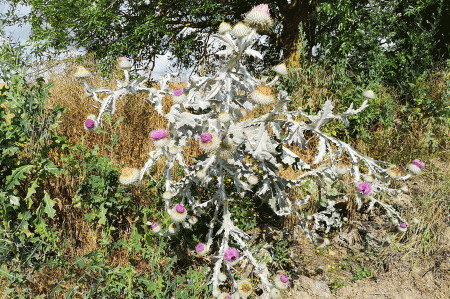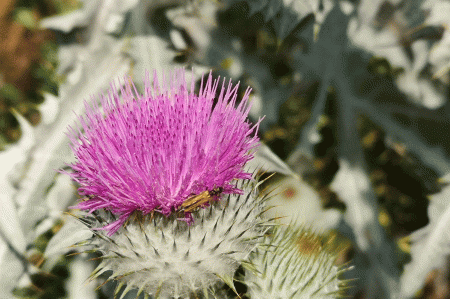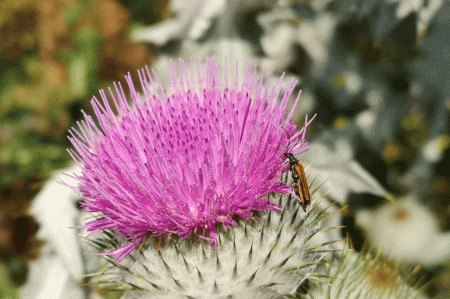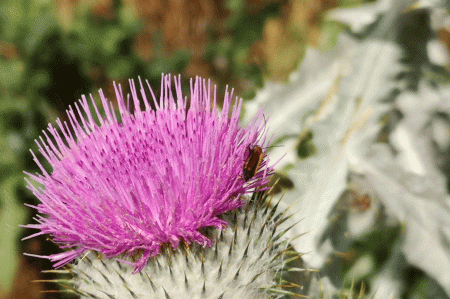Thistles - not just wild plants - a feast for the eyes in the garden
- Written by Portal Editor
Many gardeners see thistles just as weeds, but there are very attractive species and varieties that even enhance gardens and plantings.
Thistles are extremely expressive plants that attract the attention of passers-by not only with their flowers, but also with their entire growth. The species with the blue flowers in sunny locations are particularly striking. The blue tones stand out from one another in a richly contrasting manner, especially if the flower shapes also differ greatly. One advantage of the prickly plant is its drought tolerance. In addition, their flowers and fruits are a source of food for insects and birds. That is why they were even named Perennial of the Year 2019 by the Association of German Perennial Gardeners.
A feast for the eyes in the perennial bed
 Thistles are unfortunately too often dismissed as weeds - wrongly, because many species and varieties not only have beautiful flowers, but also behave extremely civilized in the perennial bed. In addition, their mostly silvery or bluish shimmer brings variety to the green leaves of the perennial beds. Thistles are also easy to care for, robust and cope well with drought and poor soil. They bloom in summer, but they are also pretty to look at outside of the blooming season, especially in winter, when hoar frost makes the seed heads sparkle or the snow puts a white cap on them. In any case, they have earned their place in the shrub bed, gravel or rock garden.
Thistles are unfortunately too often dismissed as weeds - wrongly, because many species and varieties not only have beautiful flowers, but also behave extremely civilized in the perennial bed. In addition, their mostly silvery or bluish shimmer brings variety to the green leaves of the perennial beds. Thistles are also easy to care for, robust and cope well with drought and poor soil. They bloom in summer, but they are also pretty to look at outside of the blooming season, especially in winter, when hoar frost makes the seed heads sparkle or the snow puts a white cap on them. In any case, they have earned their place in the shrub bed, gravel or rock garden.
All thistles are particularly suitable for sunny, dry places such as gravel or prairie beds. Plants with large flowers such as coneflowers, sun hats, yarrow, bearded irises or girls' eyes form a nice counterbalance. This goes well with scented nettle, blue rue and other plants with flower candles. With their light greenish yellow, milkweed species are also good partners - their foliage goes perfectly with the steel blue of the noble thistle. In addition to the rather rigid thistles, ornamental grasses provide lightness. Blue fescue, feather grass, mosquito grass and quaking grass, for example, have similar requirements as ball thistle and noble thistle.
Thistles - a food source for insects and birds
 Thistles are very bee-friendly plants and a valuable source of nectar for bees, butterflies and other insects. And it is not just the seed heads and flowers of the most diverse types of thistle that are of interest to a large number of beneficial insects: the leaves are used as food for many caterpillars such as the painted lady. Later in the year, insects use the hollow stems for winter quarters. So if you want to do something for insect protection, you will hardly find a more productive perennial - the flowers magically attract insects.
Thistles are very bee-friendly plants and a valuable source of nectar for bees, butterflies and other insects. And it is not just the seed heads and flowers of the most diverse types of thistle that are of interest to a large number of beneficial insects: the leaves are used as food for many caterpillars such as the painted lady. Later in the year, insects use the hollow stems for winter quarters. So if you want to do something for insect protection, you will hardly find a more productive perennial - the flowers magically attract insects.
In the cold months, birds are also happy about the countless seeds in the withered flower heads. It is no coincidence that the goldfinch bears its second name "Goldfinch".
The goldfinch is particularly happy about the nutritious seeds of various thistles. You can often see him acrobatically sitting on a flower head and pulling out the seeds with his long beak. Thistles are its main food.
The world of thistles has a lot more to offer: The milk thistle (Silybum marianum) is not just in demand because of the decorative green and white speckled leaves. The seeds of this thistle are used as a liver remedy. Safflower (Carthamus tinctorius) provides healthy safflower oil with polyunsaturated fatty acids. The yellow flowers replace expensive saffron and dye wool and silk. The silver thistle (Carlina acaulis) is a weather prophet: in bad weather it keeps the flower closed. As with the biennial golden thistle (Carlina vulgaris), the flowers are in demand for dry binding.
 The term "thistle" includes many prickly plants of different genera. While spherical thistles (Echinops) and man litter (Eryngium) sprout anew each year, ring thistles (Carduus), scraped thistles (Cirsium), silver thistles (Carlina acaulis) and donkey thistles (Onopordum) are short-lived guests in the garden. In the first year, the so-called two-year-olds grow into a rosette of leaves, in the following year they bloom and then die. They are easy to grow from seeds or provide for offspring by sowing them. Despite the short lifespan, some of them reach amazing sizes. The donkey thistle, for example, grows more than two meters high. The card thistle, which is planted far too seldom, is of captivating beauty. A sunny place to choose, as thistles are sun worshipers. The garden soil should be rather dry and poor. Large thistles need enough space in the bed and should not be planted by the wayside. The best times of the year to plant thistles are spring and autumn.
The term "thistle" includes many prickly plants of different genera. While spherical thistles (Echinops) and man litter (Eryngium) sprout anew each year, ring thistles (Carduus), scraped thistles (Cirsium), silver thistles (Carlina acaulis) and donkey thistles (Onopordum) are short-lived guests in the garden. In the first year, the so-called two-year-olds grow into a rosette of leaves, in the following year they bloom and then die. They are easy to grow from seeds or provide for offspring by sowing them. Despite the short lifespan, some of them reach amazing sizes. The donkey thistle, for example, grows more than two meters high. The card thistle, which is planted far too seldom, is of captivating beauty. A sunny place to choose, as thistles are sun worshipers. The garden soil should be rather dry and poor. Large thistles need enough space in the bed and should not be planted by the wayside. The best times of the year to plant thistles are spring and autumn.
Please read as well:
Christmas pyramids - an example in Eckartsberga
Sithonia is also beautiful in late autumn and winter
